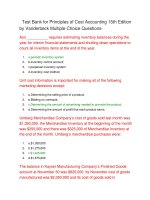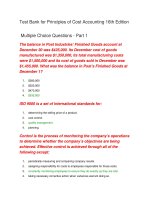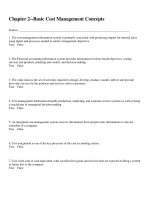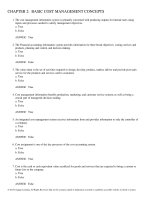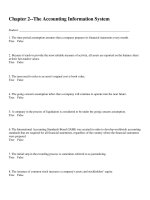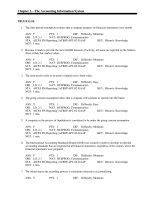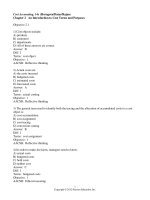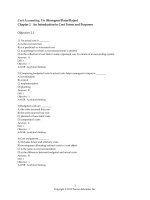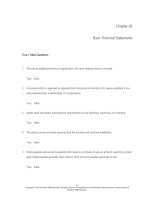Principles of cost accounting 16th edition vanderbeck test bank
Bạn đang xem bản rút gọn của tài liệu. Xem và tải ngay bản đầy đủ của tài liệu tại đây (408 KB, 84 trang )
CHAPTER 2: ACCOUNTING FOR MATERIALS
Student: ___________________________________________________________________________
1. An effective cost control system should include:
A. An established plan of objectives and goals to be achieved.
B. Regular reports showing the difference between goals and actual performance.
C. Specific assignment of duties and responsibilities.
D. All of these are correct.
2. To effectively control materials, a business must maintain:
A. Limited access.
B. Combination of duties.
C. Safety stock.
D. None of these are correct.
3. Janet is the purchasing agent at Frameco Manufacturing. Her duties include vendor selection and ordering
materials. Due to a recent economic downturn and resulting cut backs, Janet has been assigned the additional
duty or preparing receiving reports after comparing the goods received to the purchase order. This is an
example of:
A. unlimited access to materials.
B. independence of assigned functions.
C. misappropriation of assets.
D. a lack of segregation of duties.
4. Marley Company hired a consultant to help improve its operations. The consultant’s report stated that
Marley’s inventory levels are excessive and cited several negative consequences to Marley as a result. Which
of the following was not cited in the report?
A. Possible other uses for working capital now tied up in inventory
B. Production stoppages due to parts not being available
C. Higher property taxes and insurance costs
D. Large quantities of obsolete materials
5. The data used to calculate the order point include all of the following except:
A. the costs of placing an order.
B. the rate at which the material will be used.
C. the estimated time interval between the placement and receipt of an order.
D. the estimated minimum level of inventory needed to protect against stockouts.
6. Murphy Company uses 2,000 yards of material each day to make hats. It usually takes five days from the
time Murphy orders the material to when it is received. If Murphy’s desired safety stock is 6,000 yards, what is
Murphy’s order point?
A. 6,000 yards
B. 8,000 yards
C. 10,000 yards
D. 16,000 yards
7. What is the objective of the economic order quantity (EOQ) model for inventory?
A. To minimize order costs or carrying costs, whichever are higher
B. To minimize order costs or carrying costs and maximize the rate of inventory turnover
C. To minimize the total order costs and carrying costs over a period of time
D. To order sufficient quantity to economically meet the next period's demand
8. Order costs would include all of the following except:
A. Receiving clerk’s wages.
B. Storeroom keeper’s wages.
C. Purchasing department’s telephone bill.
D. Transportation in.
9. Expected annual usage of a particular raw material is 1,200,000 units, and standard order size is 10,000
units. The invoice cost of each unit is $145, and the cost to place one purchase order is $105. The estimated
annual order cost is:
A. $12,000.
B. $17,400.
C. $12,600.
D. $800,000.
10. Carrying costs would include all of the following except:
A. Warehouse rent.
B. Inspection employees’ wages.
C. Losses due to obsolescence.
D. Property taxes.
11. The following data refer to various annual costs relating to the inventory of a single-product company that
requires 10,000 units per year:
Cost per unit
$ .05
.18
.16
.10
Total per year
$800
Order cost
Transportation-in on purchases
Storage
Insurance
Interest that could have been earned on alternate investment of funds
What is the annual carrying cost per unit?
A. $ .21
B. $ .29
C. $ .34
D. $ .44
12. The following data pertains to Western Company’s materials inventory:
Number of pounds required annually
Cost of placing an order
Annual carrying cost per pound of material
16,000
$20
$4
What is Western Company’s EOQ?
A. 4,000 pounds
B. 800 pounds
C. 400 pounds
D. 200 pounds
13. Expected annual usage of a particular raw material is 180,000 units, and standard order size is 12,000 units.
The invoice cost of each unit is $300, and the cost to place one purchase order is $80. Assuming the company
does not maintain safety stock, the average inventory is:
A. 10,000 units.
B. 7,500 units.
C. 15,000 units.
D. 6,000 units.
14. Arwen Company has correctly computed its economic order quantity at 500 units; however, management
feels it would rather order in quantities of 600 units. How should Arwen's total annual order cost and total
annual carrying cost for an order quantity of 600 units compare to the respective amounts for an order quantity
of 500 units?
A. Higher total order cost and lower total carrying cost
B. Lower total order cost and higher total carrying cost
C. Higher total order cost and higher total carrying cost
D. Lower total order cost and lower total carrying cost
15. The personnel involved in the physical control of materials includes all of the following except the:
A. Purchasing agent.
B. Receiving clerk.
C. Cost accountant.
D. Production department supervisor.
16. The employee who is responsible for preparing purchase requisitions is most likely the:
A. Storeroom keeper.
B. Purchasing agent.
C. Production supervisor.
D. Receiving clerk.
17. Sam Jones works at Seeker, Inc. Sam’s duties include identifying where materials can be obtained most
economically, placing orders and verifying invoices and approving them for payment. Sam is a(n):
A. receiving clerk.
B. accounts payable clerk.
C. purchasing agent.
D. production supervisor.
18. The form used to notify the purchasing agent that additional materials are needed is known as a:
A. Purchase order.
B. Vendor's invoice.
C. Receiving report.
D. Purchase requisition.
19. The form prepared by the purchasing agent and sent to the vendor to obtain materials is known as a:
A. Materials requisition.
B. Purchase requisition.
C. Purchase order.
D. Vendor's invoice.
20. A receiving report would include all of the following information except:
A. What the shipment contained.
B. The purchase order number.
C. The customer.
D. The date the materials were received.
21. Listed below are steps of purchasing and receiving materials:
1. The receiving clerk prepares a receiving report.
2. Purchase requisitions are prepared to notify the purchasing agent that
additional
materials are needed.
3. The purchase of merchandise is recorded by the accounting department.
4. The purchasing agent completes a purchase order.
In which order would these events typically happen?
A. 4, 2, 3, 1
B. 2, 4, 3, 1
C. 2, 4, 1, 3
D. 4, 2, 1, 3
22. Listed below are steps of procuring materials for production:
1.
2.
3.
4.
The receiving clerk checks the quantity and quality of incoming materials.
The purchasing agent issue the purchase order to the vendor.
The production floor supervisor issues a materials requisition.
The storeroom clerk issues a purchase requisition.
In which order would these events typically happen?
A. 3, 2, 4, 1
B. 3, 4, 2, 1
C. 2, 1, 3, 4
D. 4, 2, 1, 3
23. The duties of the purchasing agent would include all of the following except:
A. Placing purchase orders.
B. Counting and identifying materials received.
C. Compiling information that identifies vendors and prices.
D. Verifying invoices and approving them for payment.
24. The form that serves as authorization to withdraw materials from the storeroom is known as the:
A. Materials requisition.
B. Purchase order.
C. Purchase requisition.
D. Returned materials report.
25. If a company receives a larger quantity of goods than had been ordered and keeps the excess for future use,
a(n)______________ is prepared to notify the vendor of the amount of increase to accounts payable in the
invoice.
A. credit memorandum
B. return shipping order
C. debit memorandum
D. additional purchase order
26. The Sully Company uses an industrial chemical, XRG, in a manufacturing process. Information as to
balances on hand, purchases, and requisitions of XRG is given in the following table.
Number of Kilograms
Date
Jan. 1
Jan. 24
Feb. 8
Mar. 16
Jun. 11
Aug. 18
T
ra
n
s
a
ct
io
n
B 1,000
e
gi
n
ni
n
g
b
al
a
n
c
e
P 2,500
u
rc
h
a
s
e
d
Is 700
s
u
e
d
Is 1,200
s
u
e
d
P 1,500
u
rc
h
a
s
e
d
Is 800
s
u
e
d
Price per
Kilogram
Balan
ce of
Kilog
rams
$2.00
1,000
$2.25
3,500
2,800
1,600
$2.75
3,100
2,300
Sep. 6
Oct. 15
Dec. 29
Is 1,600
s
u
e
d
P 2,000
u
rc
h
a
s
e
d
Is 600
s
u
e
d
700
$2.80
2,700
2,100
If a perpetual inventory record of XRG is maintained on a FIFO basis, the March 16 issue will consist of:
A. 300 kilograms @ $2.00 and 900 kilograms @ $2.25.
B. 1,000 kilograms @ $2.00 and 200 kilograms @ $2.25.
C. 1,200 kilograms @ $2.25.
D. 700 kilograms @ $2.00 and 500 kilograms @ $2.25.
27. The Benchley Company uses metal grates when assembling appliances. Information as to balances on
hand, purchases, and requisitions of the grates is given in the following table.
Number of Units
Unit Price
Balan
ce of
Units
$2.80
150
$3.10
600
Date
Jan. 1
Jan. 24
Feb. 8
Mar. 16
Jun. 11
Aug. 18
T
ra
n
s
a
ct
io
n
B 150
e
gi
n
ni
n
g
b
al
a
n
c
e
P 450
u
rc
h
a
s
e
d
Is 120
s
u
e
d
Is 210
s
u
e
d
P 225
u
rc
h
a
s
e
d
Is 195
s
u
e
d
480
270
$3.24
495
300
Sep. 6
Oct. 15
Dec. 29
Is 165
s
u
e
d
P 225
u
rc
h
a
s
e
d
Is 210
s
u
e
d
135
$3.40
360
150
If a perpetual inventory record of the metal grates is maintained on a FIFO basis, the September 6 issue will consist of:
A. 15 units @ $2.80, 120 units @ $3.10 and 30 units @ $3.24.
B. 75 units @ $2.80 and 90 units @ $3.10.
C. 165 units @ $3.10.
D. 75 units @ $3.10 and 90 units @ $3.24.
28. The Bisset Corporation uses Raw Material A in a manufacturing process. Information as to balances on
hand, purchases, and requisitions of Raw Material A is given in the following table.
Raw Material A
Number of Units
Unit Price
Balan
ce of
Units
$1.40
100
$1.55
400
Date
Jan. 1
Jan. 24
Feb. 8
Mar. 16
Jun. 11
Aug. 18
T
ra
n
s
a
ct
io
n
B 100
e
gi
n
ni
n
g
b
al
a
n
c
e
P 300
u
rc
h
a
s
e
d
Is 80
s
u
e
d
Is 140
s
u
e
d
P 150
u
rc
h
a
s
e
d
Is 130
s
u
e
d
320
180
$1.62
330
200
Sep. 6
Oct. 15
Dec. 29
Is 110
s
u
e
d
P 150
u
rc
h
a
s
e
d
Is 140
s
u
e
d
90
$1.70
240
100
If a perpetual inventory record of Raw Material A is maintained on a FIFO basis, 200 units on hand on August 18 will consist of:
A. 100 units @ $1.40, 80 units @ $1.55 and 20 units @ $1.62.
B. 100 units @ $1.55 and 100 units @ $1.62.
C. 150 units @ $1.62 and 50 units @ $1.55.
D. 200 units @ $1.55.
29. The Benchley Company uses metal grates when assembling appliances. Information as to balances on
hand, purchases, and requisitions of the grates is given in the following table.
Number of Units
Unit Price
Balan
ce of
Units
$2.80
150
$3.10
600
Date
Jan. 1
Jan. 24
Feb. 8
Mar. 16
Jun. 11
Aug. 18
T
ra
n
s
a
ct
io
n
B 150
e
gi
n
ni
n
g
b
al
a
n
c
e
P 450
u
rc
h
a
s
e
d
Is 120
s
u
e
d
Is 210
s
u
e
d
P 225
u
rc
h
a
s
e
d
Is 195
s
u
e
d
480
270
$3.24
495
300
Sep. 6
Oct. 15
Dec. 29
Is 165
s
u
e
d
P 225
u
rc
h
a
s
e
d
Is 210
s
u
e
d
135
$3.40
360
150
If a perpetual inventory record of the metal grates is maintained on a FIFO basis, what costs are assigned to the 150 units in ending inventory?
A. 150 units @ $3.40
B. 15 units @ $3.40 and 135 units @ $3.24.
C. 150 units @ $2.80.
D. 15 units @ $3.40 and 135 units @ $2.80.
30. The inventory method which results in the prices paid for earliest purchases assigned to cost of goods sold
is:
A. First-in, first-out.
B. Last-in, first-out.
C. Last-in, last-out.
D. Moving average.
31. The inventory method which results in the most recent costs being assigned to inventory on hand at the end
of the period is:
A. First-in, first-out.
B. Last-in, first-out.
C. Last-in, last-out.
D. Moving average.
32. Filmac, Inc. uses speakers when assembling computers. Information as to balances on hand, purchases, and
requisitions of speakers is given in the following table.
Number of Units
Unit Price
Balan
ce of
Units
$14.00
200
$16.00
300
Date
Jan. 1
Jan. 15
Feb. 24
Mar. 8
Jun. 23
Aug. 8
T
ra
n
s
a
ct
io
n
B 200
e
gi
n
ni
n
g
b
al
a
n
c
e
P 100
u
rc
h
a
s
e
d
Is 50
s
u
e
d
Is 70
s
u
e
d
P 100
u
rc
h
a
s
e
d
Is 80
s
u
e
d
250
180
$17.00
280
200
Sep. 29
Oct. 7
Dec. 16
Is 30
s
u
e
d
P 100
u
rc
h
a
s
e
d
Is 50
s
u
e
d
170
$19.00
270
220
If a perpetual inventory record of speakers is maintained on a LIFO basis, the March 8 issue will consist of:
A. 20 units @ $14.00 and 50 units @ $16.00.
B. 70 units @ $14.00.
C. 50 units @ $16.00 and 20 units @ $14.00.
D. 70 units @ $16.00.
33. The Bisset Corporation uses Raw Material A in a manufacturing process. Information as to balances on
hand, purchases, and requisitions of Raw Material A is given in the following table.
Raw Material A
Number of Units
Unit Price
Balan
ce of
Units
$1.40
100
$1.55
400
Date
Jan. 1
Jan. 24
Feb. 8
Mar. 16
Jun. 11
Aug. 18
T
ra
n
s
a
ct
io
n
B 100
e
gi
n
ni
n
g
b
al
a
n
c
e
P 300
u
rc
h
a
s
e
d
Is 80
s
u
e
d
Is 140
s
u
e
d
P 150
u
rc
h
a
s
e
d
Is 130
s
u
e
d
320
180
$1.62
330
200
Sep. 6
Oct. 15
Dec. 29
Is 110
s
u
e
d
P 150
u
rc
h
a
s
e
d
Is 140
s
u
e
d
90
$1.70
240
100
If a perpetual inventory record of Raw Material A is maintained on a LIFO basis, the September 6 issue will consist of:
A. 80 units @ $1.55, 20 units @ $1.62 and 10 units @ $1.40.
B. 110 units @ $1.55.
C. 50 units @1.55 and 60 units @ 1.62.
D. 20 units @ $1.62 and 90 units @ $1.55.
34. Pierce, Inc. uses sulfuric acid in a manufacturing process. Information as to balances on hand, purchases,
and requisitions of acid is given in the following table.
Number of Gallons
Date
Jan. 1
Feb. 24
Mar. 8
Apr. 16
May. 11
Jul. 18
T
ra
n
s
a
ct
io
n
B 10,000
e
gi
n
ni
n
g
b
al
a
n
c
e
P 30,000
u
rc
h
a
s
e
d
Is 8,000
s
u
e
d
Is 14,000
s
u
e
d
P 15,000
u
rc
h
a
s
e
d
Is 13,000
s
u
e
d
Price per
Gallon
Balan
ce of
Gallo
ns
$.50
10,00
0
$.65
40,00
0
32,00
0
18,00
0
$.72
33,00
0
20,00
0
Oct. 6
Nov. 15
Nov. 29
Is 11,000
s
u
e
d
P 15,000
u
rc
h
a
s
e
d
Is 14,000
s
u
e
d
9,000
$.78
24,00
0
10,00
0
If a perpetual inventory record of Raw Material A is maintained on a LIFO basis, the 20,000 units in inventory at July 18 will consist of:
A. 5,000 units @ $.72 and 15,000 units @ $.65.
B. 10,000 units @ $.50 and 10,000 units @ $.65.
C. 2,000 units @ $.72, 8,000 units @ $.65 and 10,000 units @ $.50.
D. 10,000 units @ $.50, 6,000 units @ $.65 and 4,000 units @ $.72.
35. The inventory method which results in the most recent cost being assigned to cost of goods sold is:
A. First-in, first-out.
B. Last-in, first-out.
C. Last-in, last-out.
D. Moving average.
36. The inventory method which results in the prices paid for the earliest purchases being assigned to inventory
on hand at the end of the period is:
A. First-in, first-out.
B. Last-in, first-out.
C. Last-in, last-out.
D. Moving average.
37. The Bisset Corporation uses Raw Material A in a manufacturing process. Information as to balances on
hand, purchases, and requisitions of Raw Material A is given in the following table.
Raw Material A
Number of Units
Unit Price
Balan
ce of
Units
$1.40
100
$1.55
400
Date
Jan. 1
Jan. 24
Feb. 8
Mar. 16
Jun. 11
Aug. 18
T
ra
n
s
a
ct
io
n
B 100
e
gi
n
ni
n
g
b
al
a
n
c
e
P 300
u
rc
h
a
s
e
d
Is 80
s
u
e
d
Is 140
s
u
e
d
P 150
u
rc
h
a
s
e
d
Is 130
s
u
e
d
320
180
$1.62
330
200
Sep. 6
Oct. 15
Dec. 29
Is 110
s
u
e
d
P 150
u
rc
h
a
s
e
d
Is 140
s
u
e
d
90
$1.70
240
100
If a perpetual inventory record of Raw Material A is maintained on a moving average basis, the 140 units issued on March 16 will have a unit cost of
(round to 3 decimal places):
A. $1.513.
B. $1.475.
C. $1.55.
D. $1.438.
38. The Kennedy Company uses throttles in its assembly of lawn mowers. Information as to balances on hand,
purchases, and requisitions of throttles is given in the following table.
Number of Units
Unit Price
Balan
ce of
Units
$2.50
50
$3.00
200
Date
Jan. 1
Jan. 20
Feb. 3
Mar. 25
Jun. 14
Aug. 27
T
ra
n
s
a
ct
io
n
B 50
e
gi
n
ni
n
g
b
al
a
n
c
e
P 150
u
rc
h
a
s
e
d
Is 40
s
u
e
d
Is 70
s
u
e
d
P 75
u
rc
h
a
s
e
d
Is 65
s
u
e
d
160
90
$4.00
165
100
Sep. 16
Oct. 7
Dec. 13
Is 55
s
u
e
d
P 75
u
rc
h
a
s
e
d
Is 70
s
u
e
d
45
$4.50
120
50
If a perpetual inventory record of throttles is maintained on a moving average basis, the 165 items in inventory on June 14 will have a unit cost of
(rounded to three decimal places):
A. $3.438.
B. $3.167.
C. $3.386.
D. $2.875.
39. In a period of rising prices, the use of which of the following cost flow methods would result in the lowest
tax liability?
A. FIFO
B. LIFO
C. Weighted average cost
D. Moving average cost
40. In a period of rising prices, the use of which of the following cost flow methods would result in the lowest
cost of goods sold?
A. FIFO
B. LIFO
C. Weighted average cost
D. Moving average cost
41. When selecting a method of inventory costing, a company must consider all of the following except:
A. federal and state income tax regulations.
B. current economic conditions.
C. the flow of materials.
D. its rate of inventory turnover.
42. At the end of the period, the balance in the Materials account should represent
A. the cost of materials purchased.
B. the cost of materials on hand.
C. the cost of materials issued into production.
D. the cost of materials included in Work in Process and Finished Goods.
43. The general ledger entry to record the purchase of materials is:
A. Debit-Purchases Received
Credit-Purchase Orders Outstanding
B. Debit-Materials
Credit-Purchase Orders Outstanding
C. Debit-Purchases Received
Credit-Accounts Payable
D. Debit-Materials
Credit-Accounts Payable
44. The journal entry to record undamaged direct materials returned to the storeroom would be:
A. Debit - Materials
Credit - Finished Goods
B. Debit - Factory Overhead
Credit - Work in Process
C. Debit - Materials
Credit - Factory Overhead
D. Debit - Materials
Credit - Work in Process
45. If the amount of materials on hand at the end of the period is less than the control account balance, the
control account balance should be decreased by the following entry:
A. Debit - Work in Process
Credit - Materials
B. Debit - Materials
Credit - Factory Overhead
C. Debit - Materials
Credit - Work in Process
D. Debit - Factory Overhead
Credit - Materials
46. Inventory levels for firms using JIT inventory systems compared to firms not using JIT will be:
A. Higher for both work in process and finished goods.
B. Higher for work in process and finished goods but lower for raw materials.
C. Lower for raw materials, work in process, and finished goods.
D. Higher for finished goods but lower for raw materials and work in process.
